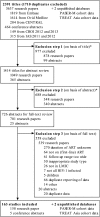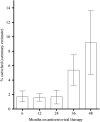Long-term Virological Outcomes of First-Line Antiretroviral Therapy for HIV-1 in Low- and Middle-Income Countries: A Systematic Review and Meta-analysis
- PMID: 26157050
- PMCID: PMC4599392
- DOI: 10.1093/cid/civ556
Long-term Virological Outcomes of First-Line Antiretroviral Therapy for HIV-1 in Low- and Middle-Income Countries: A Systematic Review and Meta-analysis
Abstract
Background: More than 11.7 million people are currently receiving antiretroviral therapy (ART) in low- and middle-income countries (LMICs), and focused efforts are needed to ensure high levels of adherence and to minimize treatment failure. Recently, international targets have emphasized the importance of long-term virological suppression as a key measure of program performance.
Methods: We systematically reviewed publications and conference abstracts published between January 2006 and May 2013 that reported virological outcomes among human immunodeficiency virus type 1 (HIV-1)-infected adults receiving first-line ART for up to 5 years in LMICs. Summary estimates of virological suppression after 6, 12, 24, 36, 48, and 60 months of ART were analyzed using random-effects meta-analysis. Intention-to-treat (ITT) analysis assumed all participants who were lost to follow-up, died, or stopped ART as having virological failure.
Results: Summary estimates of virological suppression remained >80% for up to 60 months of ART for all 184 included cohorts. ITT analysis yielded 74.7% (95% confidence interval [CI], 72.2-77.2) suppression after 6 months and 61.8% (95% CI, 44.0-79.7) suppression after 48 months on ART. Switches to second-line ART were reported scarcely.
Conclusions: Among individuals retained on ART, virological suppression rates during the first 5 years of ART were high (>80%) and stable. Suppression rates in ITT analysis declined during 4 years.
Keywords: HIV-1; antiretroviral therapy; low- and middle-income countries; virological monitoring.
© The Author 2015. Published by Oxford University Press on behalf of the Infectious Diseases Society of America. All rights reserved. For Permissions, please e-mail: journals.permissions@oup.com.
Figures




References
-
- World Health Organization. Global update on the health sector response to HIV, 2014, 2014. Available at: http://www.who.int/hiv/pub/progressreports/update2014/en/. Accessed 2 April 2015.
-
- World Health Organization. Access to antiretroviral drugs in low- and middle-income countries: technical report July 2014. Geneva, Switzerland, 2014. Available at: http://www.who.int/hiv/pub/amds/access-arv-2014/en/. Accessed 2 April 2015.
-
- Gilks CF, Crowley S, Ekpini R et al. . The WHO public-health approach to antiretroviral treatment against HIV in resource-limited settings. Lancet 2006; 368:505–10. - PubMed
-
- World Health Organization. Consolidated guidelines on the use of antiretroviral drugs for treating and preventing HIV infection—Recommendations for a public health approach. Geneva, Switzerland, 2013. Available at: http://www.who.int/hiv/pub/guidelines/arv2013/download/en/. Accessed 5 July 2013. - PubMed
Publication types
MeSH terms
Substances
Grants and funding
LinkOut - more resources
Full Text Sources
Other Literature Sources
Medical

